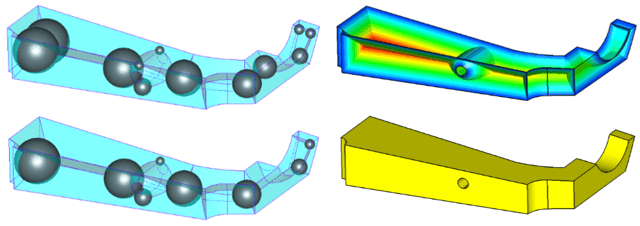Medial Object Technology
MAT and MO
The Medial Axis Transformation (MAT) was the subject of intensive research at Queen’s University Belfast in the 1980’s and was then developed by International TechneGroup, Ltd. from 2004 onwards in the form of Medial Object (MO) computation. In recent years the Medial Object has become a key geometric reasoning technology in several EU and TSB supported projects, including VIVACE, CRESCENDO, SILOET, ANSD, SimOD and GHandI. Applications of ITI’s MO have also been explored in several academic research projects. We are aware that there are also several other groups working on MAT methods and applications.

Please complete the form on this page if you are interested in receiving more information about the Medial Axis Transformation or Medial Object Technology.
CAE Geometry Workshop
Held: 14-15 September 2017, Cambridge, England
The aim of the 2017 CAE Geometry workshop was to bring together individuals and groups who are active or interested in CAE geometry and meshing problems. To access papers from the 2017 event, please visit this page: http://info.iti-global.com/cae-geometry-workshop
To access previous papers presented at the workshop in Cambridge, England, 9-10 October 2014, on the Medial Object and the Medial Axis Transformation (MAT), see below.
2014 Workshop Papers
Most papers are provided below via the links in the titles. Those of Amenta and Ali were, at the time of the workshop, material under preparation for journal publication so are not provided. The Woodhouse talk was an informal, after dinner entertainment talk and is also not available.
|
Dr Geoffrey Butlin |
International TechneGroup, Ltd. |
|
|
Dr Malcolm Sabin |
Numerical Geometry Ltd |
|
|
Dr Tom Cashman |
International TechneGroup, Ltd. |
|
|
Delaunay computation of medial axis – survey 2D mesh computation using medial axis |
Professor Nina Amenta |
University of California at Davis |
|
Scalable and robust computation of medial axes and surfaces in 2D and 3D: State-of-the-art |
Prof. dr. Alexandru C. Telea |
University of Groningen |
|
3D medial object computation using a domain Delaunay triangulation |
Henry Bucklow |
International TechneGroup, Ltd. |
|
LayTracks3D: Hex Mesh Generation using Medial Axis Transform |
Dr William Roshan Quadros |
SANDIA |
|
Toward exascale parallel mesh generation with the help of |
Professor Nikos Chrisochoides |
Old Dominion University |
|
Making a Medial Object usable in an Engineering Simulation context |
Joe Walsh |
Intrinsim |
|
Dr Harry Fogg |
Queen’s University Belfast |
|
|
Mesh Generation for Aircraft Engines based on the Medial Axis |
Dr Florian Buchegger |
Johannes Kepler University |
|
Need for hex meshing with MO |
Alex Sansom |
Rolls-Royce |
|
Dr Malcolm Sabin |
Numerical Geometry Ltd |
|
|
AFTER DINNER TALK: When does a structure become an instrument |
Professor Jim Woodhouse |
Cambridge University Engineering Department |
|
Professor Wenping Wang |
University of Hong Kong |
|
|
Professor Frederic Fol Leymarie |
Goldsmiths University of London |
|
|
Dr Jiří Kosinka |
Cambridge University Computer Laboratory |
|
|
Professor M. Ramanathan |
IIT Madras |
|
|
Computing medial axis and curve skeleton with Voronoi diagrams |
Professor Tamal Dey |
The Ohio State University |
|
Dr Ted Blacker |
SANDIA |
|
|
Dr Helen Lockett |
Cranfield University |
|
|
Medial Axis Based Mesh Generation Applied to Turbomachinery Flows |
Zaib Ali |
Cambridge University Engineering Department |
|
Dr Scott Shaw |
AIRBUS |
|
|
& Robin Fairey |
International TechneGroup, Ltd. |